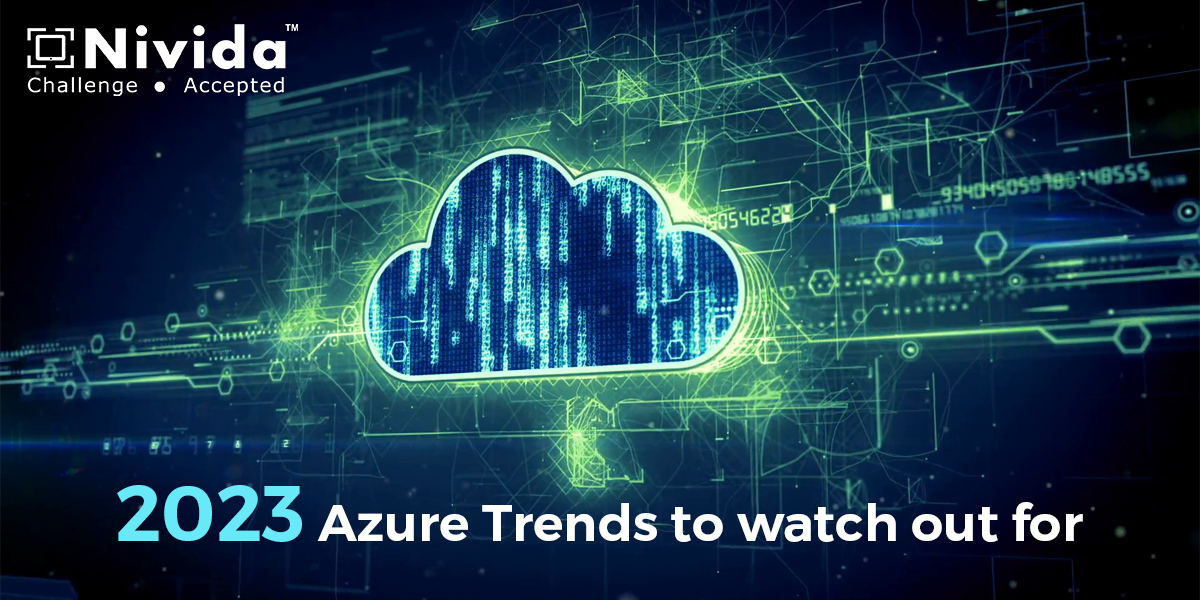In order to facilitate the distribution of digital services, cloud computing is being increasingly utilised by businesses worldwide. Forecasts from a research firm indicate that by 2023, expenditure on cloud services across the globe would have increased to more than $482 billion, from $313 billion in 2020. To adapt to the rise of the hybrid workforce, improve efficiency in daily tasks, ensure the continuity of operations, tighten security, and increase resilience, businesses are increasingly turning to cloud services for their information technology needs.
When it comes to the cloud computing market, Microsoft Azure is a major player. Microsoft Azure's platform for cloud computing continues to evolve and improve at a rapid pace, giving its users a leg up on the competition by keeping them one step ahead of the curve. Let's take a look at the top Azure technological developments we should be watching for in the year 2023.
- The Pinnacle of Hybrid and Multi-cloud Computing:
- Increase in Serverless, Event-driven Containers
- Incredibly Quick AI Adoption at the Periphery:
- The Rise of Zero-Trust Cloud Security.
- Implementing XOps and Hyper Automation for Digital Transformation.
- Complete AI/ML/Data Analytics Platforms: On the Cusp of Mass Adoption
- Cloud-Based Infrastructure for the Internet of Things Keep Growing Up:
- Innovative Vertical Solutions for Disruptive Industries:
Since the global pandemic, more organisations have opted to use hybrid and multi-cloud architectures. Nonetheless, there is inherent complexity and hazards in managing several cloud and on-premises environments. Azure Stack Edge as well as Azure ARC are just a couple of the Azure-managed services and solutions that can be used in tandem with Azure's hybrid capabilities to overcome a wide range of problems.
Hybrid, familiar, hyper-converged Azure infrastructure is made possible by Azure Stack HCI and Azure Arc, enabling Azure features to run anywhere, from the data centre to the edge, remote offices, and disconnected settings. Furthermore, highly available OpenShift clusters can be deployed on-demand with automated operations thanks to the capabilities of Azure Red Hat OpenShift.
New development patterns that maximise agility, efficiency, and adaptability are made possible by cloud-native and serverless architecture. According to a 2023 market prediction, the SaaS market would be worth USD 145,377 billion, while the PaaS market will be worth USD 71.5 billion. With event-driven microservices architectures, most businesses are increasingly turning to PaaS-based services and serverless apps. There is a wide selection of serverless computing as well as container services available via Microsoft Azure. The solution consists of the AKS virtual nodes, Azure Kubernetes Service (AKS), Azure Functions, Kubernetes-based Event-Driven Autoscaling (KEDA), Azure App Services, as well as Azure Container Apps, and it allows for the rapid development and deployment of large-scale applications while minimising the burden on IT staff in terms of provisioning and managing the underlying infrastructure.
Edge computing enables a collection of interconnected systems and devices to collect and analyse data in close proximity to the point of generation and the end user, bridging the gap between the cloud and the network's edge. By 2028, the worldwide edge computing market is expected to be worth USD 61.14 billion, expanding at a CAGR of 38.4 per cent. Low-latency intelligence may be achieved through the use of AI services offered by Azure such as Azure Cognitive Services, which bring a trained AI model to the edge and integrate it with your applications. With the use of containers, it does analysis near the system in which the data sits, allowing it to provide instantaneous insights.
Today, businesses of all stripes must prioritise cloud security. To safeguard today's widely dispersed and intricately networked businesses against cyber criminals, IT departments have adopted a Zero-trust security approach. The foundation of this model is ongoing trust and verification. It entails verifying users' devices, identities, as well as services on a regular basis in order to control who has access to what within an organisation. Businesses can save an average of 90 per cent of the money lost due to security events if they implement current cyber security mesh designs.
For the next five years, Microsoft plans to invest USD 20 billion into cybersecurity initiatives like "Microsoft Defender Cloud," which is fueled by Microsoft Threat Intelligence, SASE, as well as security system upgrades. Microsoft is hard at work expanding its Azure platform with features like Azure Chaos Studio as well as Azure Confidential Computing, both of which aim to introduce zero-trust cloud security and compliance norms.
The spread of automation technology has allowed them to permeate many areas of labour. Combining RPA with AI technologies like cognitive services results in hyper- and intelligent-level automation. To speed up digital transformation, end-to-end business process automation is essential, and machine learning is a key enabler for this. McKinsey estimates that by 2020, robots, automated processes, 3D printers, and other similar technologies will produce data of around 79.4 zettabytes annually.
AI and ML processes can now be implemented across an organisation thanks to the next generation of data operations. This is known as "extreme operations," because it permits the operationalization of processes and automation from the outset. Standardization, governance, and control must be pushed throughout the entire enterprise, therefore automating XOps like SecOps, MLOps, DevOps, DataOps, AIOps, as well as comprehensive end-to-end automation platforms becomes crucial.
As the fields of artificial intelligence (AI), machine learning (ML), and data analytics develop in real-time, they have caused disruptions for businesses. From 2021 to 2028, the Grand View Research report forecasts that the size of the worldwide artificial intelligence market will increase at a CAGR of 40.2%. The next step is to create comprehensive data analytics, ML, as well as AI platforms and use them as primary drivers of the business process. It was already firmly established in many other fields, including AIOps, data monetization and analytics, hyper-automation, IoT, simulations, edge devices, cyber security, augmented analytics, decision intelligence, and many others. The cloud services provided by Microsoft Azure include Azure Synapse for comprehensive data analytics and the machine learning capabilities of Azure Databricks as well as Azure ML Studio. Applied and Cognitive AI services, Azure Kubernetes Services (AKS) as well as containers, all work together to automate and improve the digital experience of your business's operations.
The internet of things is another developing technology trend. It offers automation improvements in many areas, such as manufacturing with predictive maintenance, healthcare with faster services and better customer experiences, and much more. With a Compound Annual Growth Rate (CAGR) of 12.6% between 2018 and 2025, MarketsandMarkets expects the global market size of IoT cloud platforms to touch USD 11.5 billion mark by 2025. Azure IoT Central, Azure Digital Twins, as well as Azure IoT Hub, are all part of Microsoft's Azure IoT platform and serve as the foundation upon which more advanced IoT use cases may be built and deployed.
Additionally, in recent years, vertical industry solutions have become more common. The term "industry vertical cloud solutions" refers to packages of services, tools, and apps on the cloud that are tailored to the unique needs of a given industry. In addition to Azure cloud services, Microsoft's specialised industry cloud solutions also incorporate industry-specific components, cross-cloud connectors, standards, as well as processes. Microsoft's Industry vertical solutions help modernise business processes in a wide range of sectors, from healthcare to manufacturing to financial services. In healthcare, for example, AI and conversational interfaces help healthcare professionals provide better care for patients. In addition to retail, Azure also offers vertical solutions for the energy sector, the media industry, and non-profit organisations.

